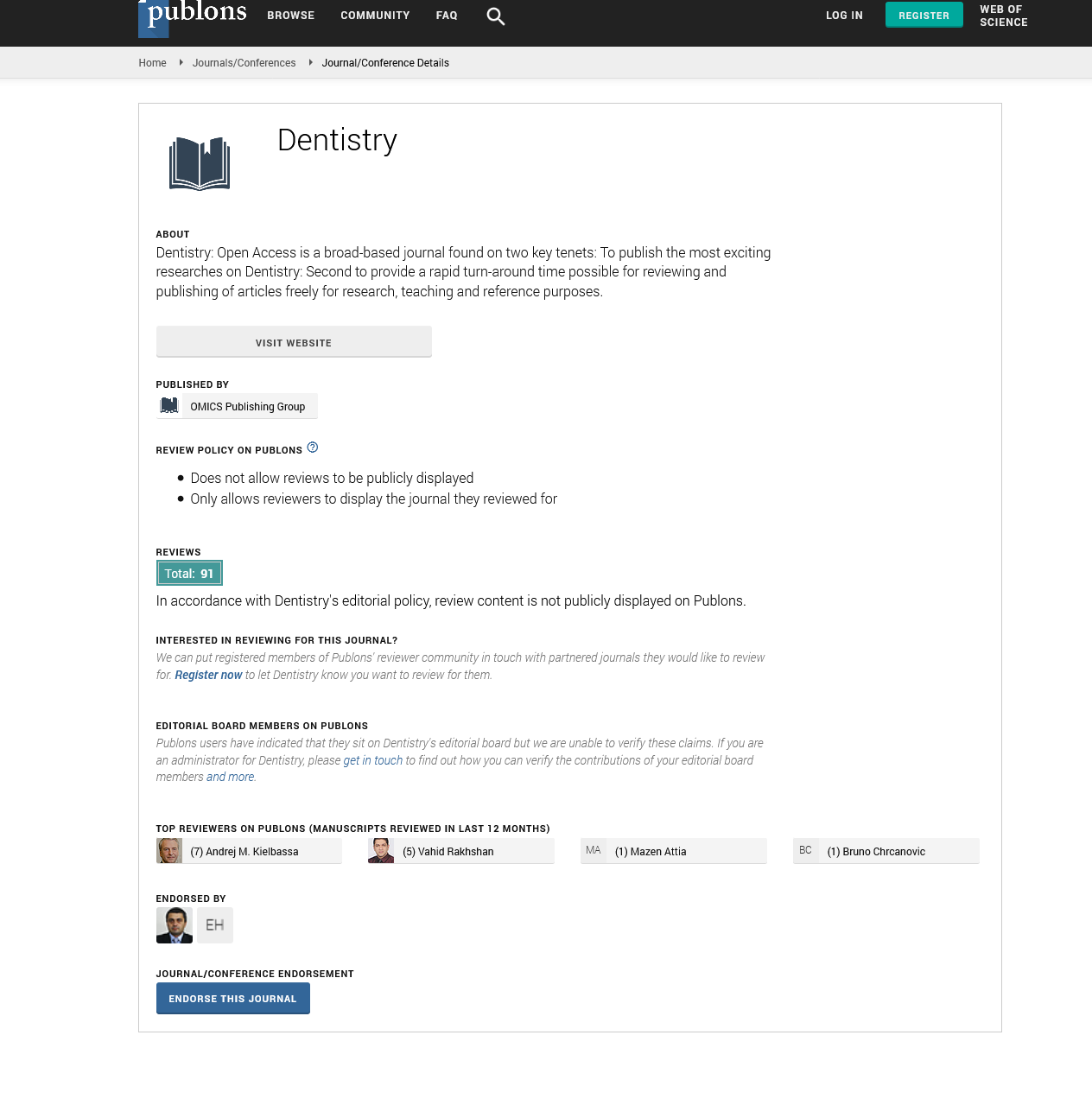Citations : 2345
Dentistry received 2345 citations as per Google Scholar report
Indexed In
- Genamics JournalSeek
- JournalTOCs
- CiteFactor
- Ulrich's Periodicals Directory
- RefSeek
- Hamdard University
- EBSCO A-Z
- Directory of Abstract Indexing for Journals
- OCLC- WorldCat
- Publons
- Geneva Foundation for Medical Education and Research
- Euro Pub
- Google Scholar
Useful Links
Share This Page
Journal Flyer

Open Access Journals
- Agri and Aquaculture
- Biochemistry
- Bioinformatics & Systems Biology
- Business & Management
- Chemistry
- Clinical Sciences
- Engineering
- Food & Nutrition
- General Science
- Genetics & Molecular Biology
- Immunology & Microbiology
- Medical Sciences
- Neuroscience & Psychology
- Nursing & Health Care
- Pharmaceutical Sciences
Commentary - (2025) Volume 15, Issue 1
Reaction of Periodontal Tissue to Anti-Adhesive and Antibacterial Resins
Edgar Richardson*Received: 25-Feb-2025, Manuscript No. DCR-25-28552; Editor assigned: 27-Feb-2025, Pre QC No. DCR-25-28552 (PQ); Reviewed: 13-Mar-2025, QC No. DCR-25-28552; Revised: 20-Mar-2025, Manuscript No. DCR-25-28552 (R); Published: 27-Mar-2025, DOI: 10.35248/2329-9088.25.15.716
Description
Dental resin filling materials have undergone significant advancements to improve their mechanical properties, biocompatibility and antibacterial effects. One of the latest developments includes anti-adhesive and antibacterial properties designed to reduce biofilm formation and bacterial growth, which are leading causes of secondary caries and gingival inflammation. While these materials are intended to enhance oral health, their effect on gingival fibroblasts remains a critical aspect to evaluate. Gingival fibroblasts play a key role in maintaining periodontal tissue integrity, wound healing and response to foreign materials.
Composition of anti-adhesive and antibacterial resin fillings
New resin formulations incorporate various bioactive compounds to improve resistance against bacterial colonization.
Release of therapeutic ions: Some materials release fluoride, calcium, or phosphate ions, which contribute to enamel remineralization while preventing bacterial proliferation.
Photocatalytic additives: Titanium dioxide nanoparticles have been explored for their ability to reduce bacterial load upon light activation.
Each of these modifications is designed to prevent bacterial biofilm formation while ensuring the material maintains its mechanical strength and longevity in the oral cavity.
Impact on gingival fibroblast viability
Assessing the biocompatibility of these materials involves examining how they influence gingival fibroblast survival. Studies utilizing cell viability assays such as MTT and Alamar Blue have shown varied responses depending on the composition of the resin.
Cytotoxicity of antimicrobial additives: Some antibacterial agents, particularly at high concentrations, have demonstrated cytotoxic effects by reducing fibroblast viability. Silver nanoparticles, for instance, have shown dose-dependent toxicity, leading to potential concerns over long-term exposure.
Surface modifications and cell adhesion: Anti-adhesive coatings may affect fibroblast attachment and proliferation. While preventing bacterial adhesion is beneficial, it is essential that these materials do not impede normal cell function.
Ion-releasing formulations: Fluoride and calcium-releasing resins have demonstrated a neutral or even beneficial effect on fibroblast activity, promoting mineralization and cell proliferation.
Effect on fibroblast proliferation and migration
For dental restorations to be biocompatible, they should not interfere with normal fibroblast proliferation and migration, which are essential for tissue repair and response to inflammation.
Increased proliferation with ion-releasing resins: Fluoride and bioactive glass-releasing formulations have supported fibroblast proliferation and migration, which may aid in periodontal health.
Negative effects of certain antimicrobial agents: High concentrations of quaternary ammonium compounds and silver nanoparticles have, in some cases, led to reduced fibroblast migration due to oxidative stress and membrane disruption.
Surface texture influence: Smooth, non-adhesive surfaces may discourage fibroblast attachment, potentially affecting gingival integration around restorative materials.
Inflammatory response and gene expression
Gingival fibroblasts regulate inflammation through cytokine release and gene expression changes in response to foreign materials. Several studies have investigated how these new resin materials modulate inflammation.
Reduced pro-inflammatory cytokine expression: Some antibacterial materials have been reported to lower the expression of IL-6 and TNF-α, suggesting a reduced inflammatory response.
Potential for oxidative stress: Certain antimicrobial additives, especially metal-based nanoparticles, have been linked to increased Reactive Oxygen Species (ROS) production, which could lead to inflammation and cellular damage.
Balanced response with bioactive additives: Materials incorporating bioactive compounds such as calcium phosphate have demonstrated a balanced inflammatory response, promoting tissue healing while reducing bacterial accumulation.
Long-term considerations for clinical use
Understanding the interaction between gingival fibroblasts and new dental resin materials is essential for their clinical application.
Material degradation over time: Some antimicrobial components may leach out over time, affecting both their antibacterial properties and impact on surrounding tissues.
Sustained biocompatibility: Ensuring that fibroblasts can maintain their function and attachment to these materials is essential for periodontal health.
Balancing antibacterial effects with tissue compatibility: The ideal resin formulation should effectively reduce bacterial growth without negatively affecting cell viability, proliferation, or inflammatory response.
Citation: Richardson E (2025). Reaction of Periodontal Tissue to Anti-Adhesive and Antibacterial Resins. J Dentistry. 15:716.
Copyright: © 2025 Richardson E. This is an open-access article distributed under the terms of the Creative Commons Attribution License, which permits unrestricted use, distribution, and reproduction in any medium, provided the original author and source are credited.

